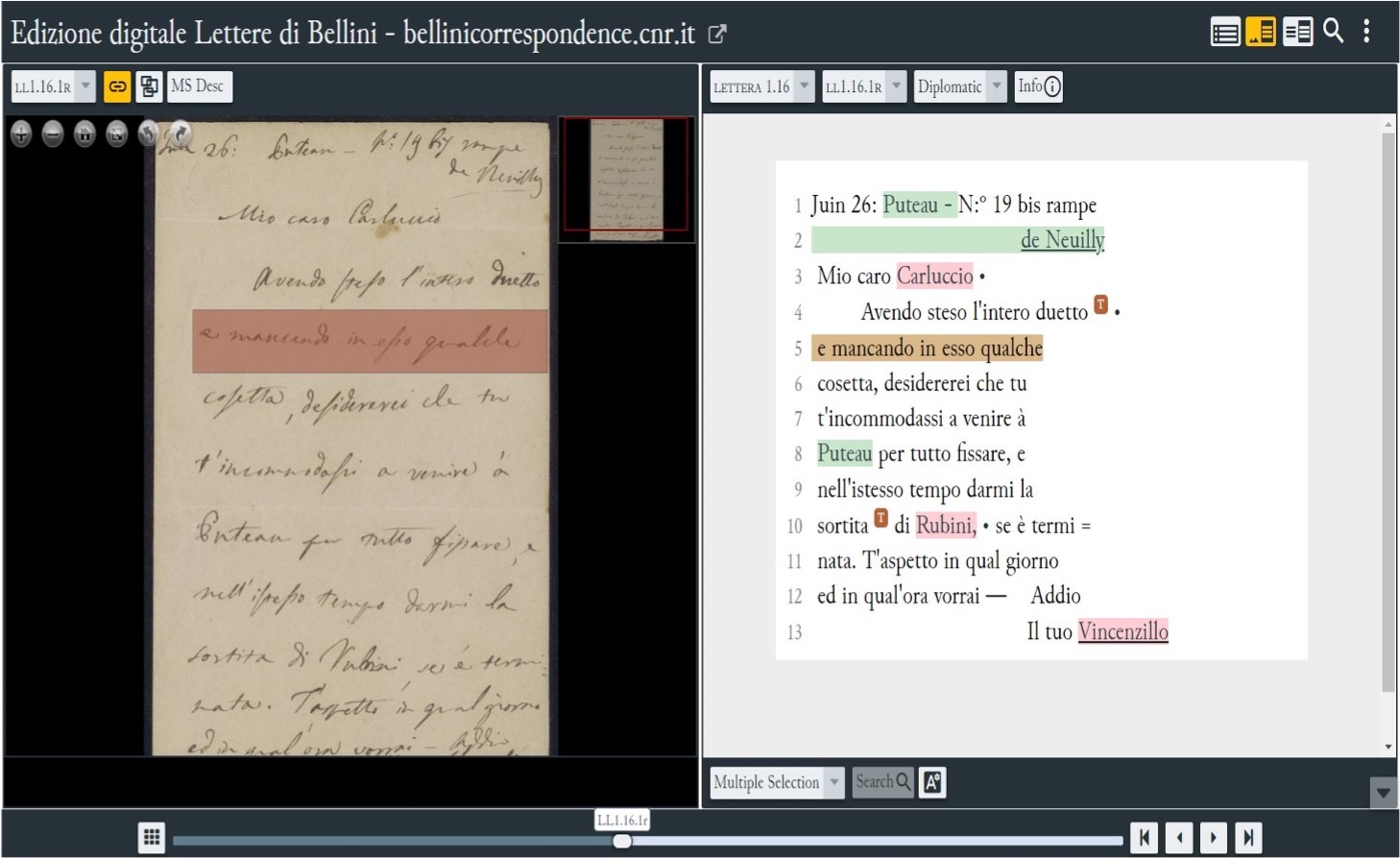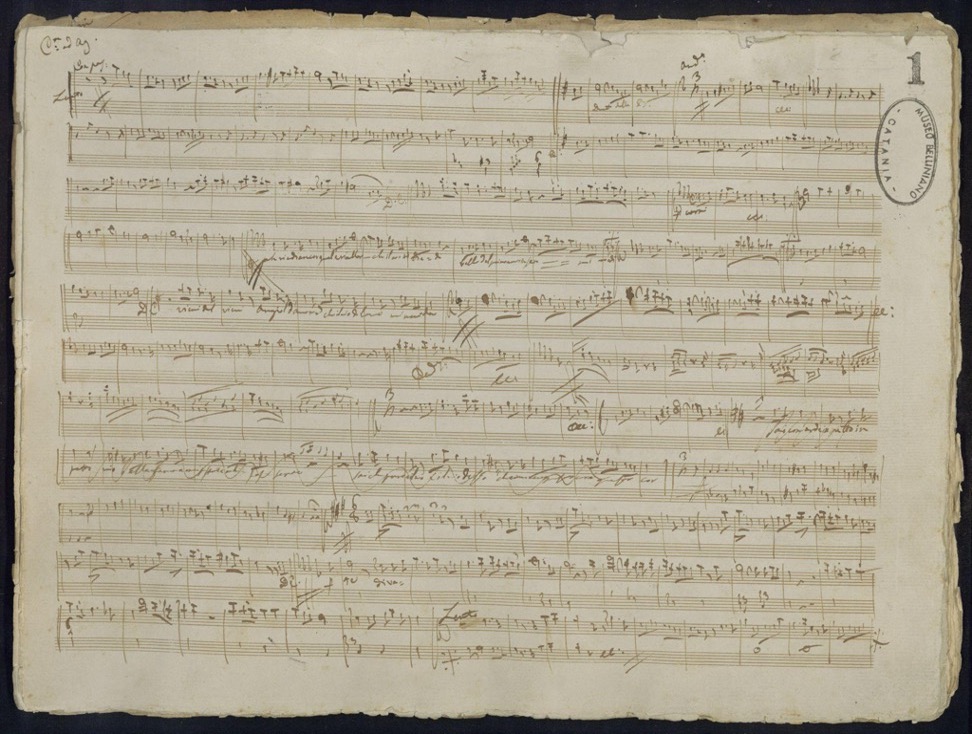Bellini Digital Correspondence meets MEI
Authors: Mazzagufo, Laura / Sichera, Pietro / Spampinato, Daria / Del Grosso, Angelo Mario
Date: Thursday, 7 September 2023, 11:15am to 12:45pm
Location: Main Campus, L 2.202 <campus:measure>
Abstract
Bellini Digital Correspondence (BDC) is the digital scholarly edition constituted by the 40 autograph letters of Vincenzo Bellini (1801-1835) held at the Museo Belliniano in Catania, Italy. The project was conceived and developed by the National Research Council of Italy and it aims at providing a web platform (<http://bellinicorrespondence.cnr.it>) for digital philology of Bellini’s texts. At the same time, it is addressed both to specialists and to occasional museum visitors, who can consult the edition by means of a touchscreen located within the museum tour. BDC is a completely open source and open access project and it is the result of a multidisciplinary initiative which implements a distributed, collaborative and cooperative editing model.
The digital edition is an image-based one and it has been implemented following the TEI guidelines. The web-based presentation of the edition has been achieved through EVT software (<http://evt.labcd.unipi.it/> (Figure 1). Particular attention was paid to the management of metadata concerning the description of the correspondence, which were encoded through the <correspDesc> tagset within the profileDesc section of the teiHeader. The TEI Manuscript Description module and the <facsimile> tagset also provided an encoding mechanism for describing the primary source and linking the facsimile regions of interest with the corresponding text. The editorial process went through several phases, including one dedicated to the harmonisation and standardisation of TEI encoding, during which a number of tools – reusable in similar encoding initiatives – were developed with the aim of ensuring the highest level of uniformity and consistency within the edition. The edition provides both diplomatic and interpretive levels based on the recent work made by Seminara (2017).
In addition to a large corpus of correspondence, the Museum safeguards numerous musical documents: these include 58 manuscripts (41 autographs) containing music by Bellini (2100 sheets ca.). These documents provide significant evidences of different genetic stages concerning all of the Catanian composer’s operas, from ‘Adelson and Salvini’ (1824) to ‘I Puritani’ (1834). In addition to their location in the Museo Belliniano in Catania, letters and manuscript scores share several points (references to names of persons, entities and places, references to operas and some arias in particular, references to specific compositional processes reflected in the drafts of the manuscript scores, etc.) but, unlike the correspondence, most of the Museum’s musical resources lack a scholarly digital edition.
The MEI encoding of some of these documents can be an important advancement towards the investigation of Bellini’s oeuvre, especially in relation to the ongoing philological studies and formal ontologies. In particular, the encoded musical documents can be further exploited to analyse the composer’s creative process, according to the approach successfully used in other similar projects (<https://beethovens-werkstatt.de/>). Moreover, thanks to the MEI encoding, the BDC project would provide an interactive and functional digital representation of different editorial stages made by Bellini to produce his text, such as, for example, the so-called ‘Studi giornalieri’ (Figure 2) catalogued as ‘MM.B.36’: sketches of melodies, textual annotations, and first draft of musical motifs partly included in the ‘Puritani’ and already covered in recent studies (Mantica 2020). Module 11 (Scholarly Editing with MEI) and Module 8 (Lyrics and Performance Directions) of MEI Guidelines will be particularly valuable for primary source encoding.
In our opinion, the edition of these musical texts and the digital representation of their primary sources are an interesting case study to investigate Bellini’s working method, as described in various letters written by the composer. The short-term objective is to combine the edition of the letters (published in May 2023 by CNR Edizioni) with a web-visualisation proposal focused on a selection of fragments derived from this musical material, in order to formulate a working hypothesis that, by considering an integration of the museum’s different artifacts, may be of interest and usefulness to Bellini scholars. The future prospects of the project will, therefore, be oriented towards a more comprehensive integration between text and music within the edition, with a view to a potential extension of the visualisation tool to include musical content as well.


Bibliography
Bellini, Vincenzo. 2017. Carteggi. Seminara, Graziella (Ed.). Firenze: Leo S. Olschki Editore.
Cristofaro, Salvatore; Spampinato, Daria. “OntoBellini: Towards an RDA Based Ontology for Vincenzo Bellini’s Cultural Heritage”. 2019. In A. Barton, S. Seppälä, D. Porello (Eds.), Proceedings of the Joint Ontology Workshops 2019, Graz (Austria), September 23-25, volume 2518 of CEUR Workshop Proceedings.
Del Grosso, Angelo Mario; Capizzi, Erica; Cristofaro, Salvatore; De Luca, Maria Rosa; Giovannetti, Emiliano; Marchi, Simone; Seminara, Graziella; Spampinato, Daria. 2019. “Bellini’s Correspondence: a Digital Scholarly Edition for a Multimedia Museum”. In Umanistica Digitale 3(7): 23-47.
Geertinger, Alex Teich. 2021. “Digital Encoding of Music Notation with MEI”. In M. S. Bue, A. Rockenberger (Eds.), Notated Music in the Digital Sphere. Possibilities and Limitations 15, of Nota bene - Studies from the National Library of Norway: 35-56. Oslo: National Library of Norway.
Mantica, Candida Billie. 2020. “Gli ‘studi giornalieri’ di Bellini «sviluppati con effetto» nei Puritani”. In Bollettino di Studi Belliniani 6: 29-73.
Pellino, Santa; Sichera, Pietro; Del Grosso, Angelo Mario; Spampinato, Daria. 2022. “Dalla codifica alla fruizione: l’edizione digitale Bellini Digital Correspondence”. In F. Ciracì, G. Miglietta, C. Gatto (Eds.), AIUCD 2022 - Proceedings. Quaderni di Umanistica Digitale: 163-8.
About the authors
Laura Mazzagufo graduated in Musicology from the University of Pavia, and she is currently pursuing a Digital Humanities degree at the University of Pisa while actively contributing to the Bellini Digital Correspondence project. Her research interests encompass text encoding and music philology.
Pietro Sichera was a Research Fellow at the Istituto di Scienze e Tecnologie della Cognizione (ISTC) – CNR in Catania, Italy. He earned his degree in Computer Science from the University of Catania and obtained his PhD degree in Lexicography and Semantics of European Literary Language, furthering his expertise in the study of the Italian language through the concordance method. He has developed proprietary software for text analysis on Italian poets of the 20th century. Currently, he teaches Computer Science in Secondary Schools.
Daria Spampinato is a researcher at the CNR ISTC in Catania, Italy, specialising in Computer Science with a focus on Digital Humanities. She is a member of the Board of the Italian Association for Humanities and Digital Cultures. Currently, her research interests cover Digital Philology and Digital Epigraphy, and she is actively engaged in the Bellini Digital Correspondence project.
Angelo Mario Del Grosso is a software engineer; he earned his PhD in Information Engineering with a thesis on the design of software components for textual scholarship. Since 2019, he has been a confirmed researcher at the CNR-ILC in Pisa. His main research activities encompass the representation and processing of philological resources. His interests are as much aimed at the formal modelling of text as at the computational analysis of textual documents. He is involved in different research projects both nationally and internationally and he teaches text encoding at the University of Pisa.
Contribution Type
Keywords